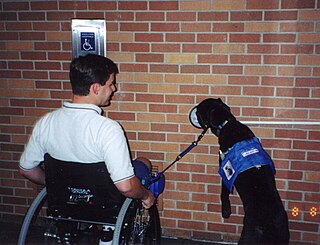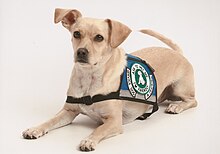A mental disorder, also referred to as a mental illness or psychiatric disorder, is a behavioral or mental pattern that causes significant distress or impairment of personal functioning. A mental disorder is also characterized by a clinically significant disturbance in an individual's cognition, emotional regulation, or behavior. It is usually associated with distress or impairment in important areas of functioning. There are many different types of mental disorders. Mental disorders may also be referred to as mental health conditions. Such features may be persistent, relapsing and remitting, or occur as single episodes. Many disorders have been described, with signs and symptoms that vary widely between specific disorders. Such disorders may be diagnosed by a mental health professional, usually a clinical psychologist or psychiatrist.

Guide dogs are assistance dogs trained to lead blind or visually impaired people around obstacles. Although dogs can be trained to navigate various obstacles, they are red–green colour blind and incapable of interpreting street signs. The human does the directing, based on skills acquired through previous mobility training. The handler might be likened to an aircraft's navigator, who must know how to get from one place to another, and the dog is the pilot, who gets them there safely. In several countries guide dogs, along with most other service and hearing dogs, are exempt from regulations against the presence of animals in places such as restaurants and public transportation.

In general, an assistance dog, known as a service dog in the United States, is a dog trained to aid or assist an individual with a disability. Many are trained by an assistance dog organization, or by their handler, often with the help of a professional trainer.

A therapy dog is a dog that is trained to provide affection, comfort and support to people, often in settings such as hospitals, retirement homes, nursing homes, schools, libraries, hospices, or disaster areas. In contrast to assistance dogs, which are trained to assist specific patients with their day-to-day physical needs, therapy dogs are trained to interact with all kinds of people, not just their handlers.
Developmental disability is a diverse group of chronic conditions, comprising mental or physical impairments that arise before adulthood. Developmental disabilities cause individuals living with them many difficulties in certain areas of life, especially in "language, mobility, learning, self-help, and independent living". Developmental disabilities can be detected early on and persist throughout an individual's lifespan. Developmental disability that affects all areas of a child's development is sometimes referred to as global developmental delay.

A mobility assistance dog or mobility service dog is a dog trained to assist a physically disabled person who has mobility issues, such as poor balance or being a non-ambulatory wheelchair user. Roles include "providing balance and stability" picking up and carrying objects, pulling wheelchairs, opening and closing doors, and operating light switches. Mobility assistance dogs can have significant positive impacts on the lives of their handlers.

An autism assistance dog or autism service dog is an assistance dog trained to assist a person with autism to help them gain independence and the ability to perform activities of daily living similar to people without autism.

A cape, jacket, or vest is an article worn by a working dog to identify or assist them in their job.
A mental health professional is a health care practitioner or social and human services provider who offers services for the purpose of improving an individual's mental health or to treat mental disorders. This broad category was developed as a name for community personnel who worked in the new community mental health agencies begun in the 1970s to assist individuals moving from state hospitals, to prevent admissions, and to provide support in homes, jobs, education, and community. These individuals were the forefront brigade to develop the community programs, which today may be referred to by names such as supported housing, psychiatric rehabilitation, supported or transitional employment, sheltered workshops, supported education, daily living skills, affirmative industries, dual diagnosis treatment, individual and family psychoeducation, adult day care, foster care, family services and mental health counseling.

Animal-assisted therapy (AAT) is an alternative or complementary type of therapy that includes the use of animals in a treatment. The goal of this animal-assisted intervention is to improve a patient's social, emotional, or cognitive functioning. Studies have documented some positive effects of the therapy on subjective self-rating scales and on objective physiological measures such as blood pressure and hormone levels.
Emotional and behavioral disorders refer to a disability classification used in educational settings that allows educational institutions to provide special education and related services to students who have displayed poor social and/or academic progress.
Canine Companions for Independence is a US-based 501(c)(3) nonprofit organization that trains and provides assistance dogs. As of 2018, it has placed over 6,000 assistance dogs with recipients at no charge.

A medical response dog is a assistance dog trained to assist an individual who has a medical disability. Typically, they are dogs whose job does not handle primarily epilepsy or psychiatric-based conditions, though some seizure response dogs or psychiatric service dogs may also be referred to as medical response.

Various definitions exist for a service animal. The Americans with Disabilities Act defines the term as "dogs that are individually trained to do work or perform tasks for people with disabilities". Dogs are the most common service animals, having assisted people since at least 1927.
An emotional support animal (ESA) is an animal that provides relief to individuals with "psychiatric disability through companionship." Emotional support animals may be any type of pet, and are not recognized as service animals under the Americans with Disabilities Act.
Bonita M. Bergin is an American canine researcher. She is the inventor of the concept of the service dog. She is the founder and president of the Bergin University of Canine Studies and the founder of Canine Companions for Independence and Paws for Purple Hearts.

Pets for Vets is a 501(c)(3) non-profit organization in the United States dedicated to providing a second chance to shelter dogs by rescuing, training, and matching them with American veterans who need a companion pet. It was founded in 2009 to help veterans who were suffering from combat stress and other emotional issues. Each companion dog is rescued in connection with local animal rescue groups.

Separation anxiety in dogs describes a condition in which a dog exhibits distress and behavior problems when separated from its handler. Separation anxiety typically manifests within minutes of departure of the handler. It is not fully understood why some dogs suffer from separation anxiety and others do not. The diagnosis process often leads to a misdiagnosis as it is difficult to differentiate from other medical and behavioral problems. The behavior may be secondary to an underlying medical condition. With chronic stress, impairments to physiological health can manifest. Increased stress in the dog alters hormone levels, thus decreasing natural immunity to various health problems.

Human–canine bonding is the relationship between dogs and humans. This relationship can be traced back to at least 15,000 years ago, to the Bonn-Oberkassel dog, who was found buried alongside two humans. For centuries, dogs have been considered man's best friend. This is most evident in western countries, such as the United States, where over 48% of households have a pet dog.

In the United States, a courthouse facility dog is a professionally trained facility dog that has graduated from an accredited assistance dog organization that is a member of Assistance Dogs International. Such dogs assist crime victims, witnesses and others during the investigation and prosecution of crimes, as well as during other legal proceedings. Courthouse facility dogs also provide assistance to Drug Court and Mental Health Court participants during their recovery from drugs, alcohol, mental illness and posttraumatic stress disorder.














